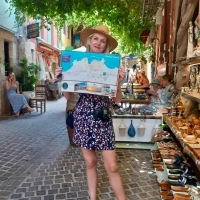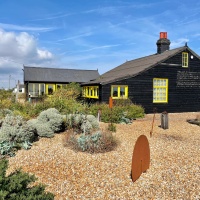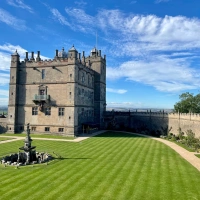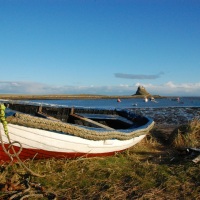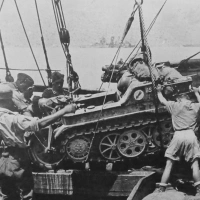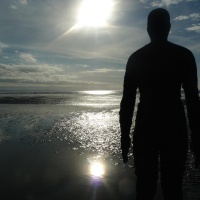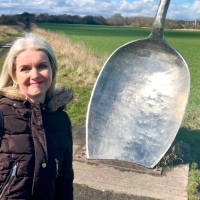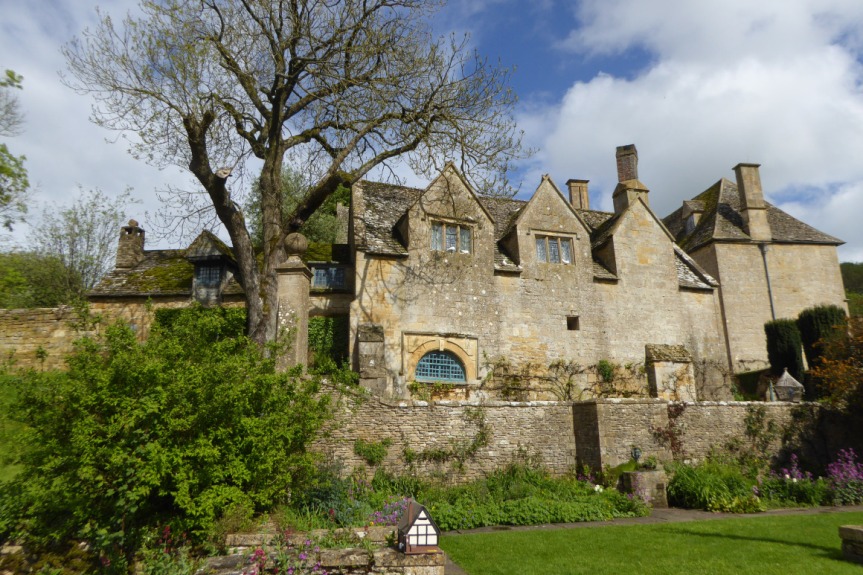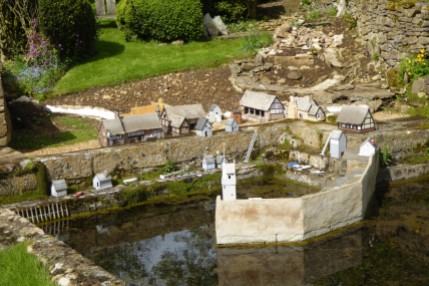
The tiny village of Bowes is a sleepy backwater with grey stone cottages, mansions and the ruins of an imposing Norman castle. But its quiet setting amidst the scenic North Pennines Hills hides a darker history.
Bowes became famous for the “schools for scandal” in Victorian times. Its most notorious incarnation was Dotheboys Hall, said to have inspired the infamous school in Charles Dickens’ “Nicholas Nickelby”.
These schools were frequently brutal with cruel, tyrannical teachers who ran their institutions like juvenile prisons. They were rarely checked so were able to impose their own harsh, unregulated regimes and teaching methods.
But how did the remote village of Bowes become a hotbed of schools for ‘cast-off’ Victorian children?
‘Schools for Scandal’


Photographs – The notorious “Dotheboys Hall” in Bowes – converted into cottage apartments
Stumbling upon Dotheboys’ Hall comes as a surprise if you take a detour off the busy A66 which rumbles alongside the village of Bowes in County Durham.
A drab stone building at the top end of the high street is all that remains of Dickens’ infamous boarding school for boys. Schools like this provided education for young pupils sent north by their families to get rid of them.
With its menacing headmaster, Wackford Squeers and his equally cruel wife, Dotheboys became the best-known fictional example of these so-called “schools for scandal”.

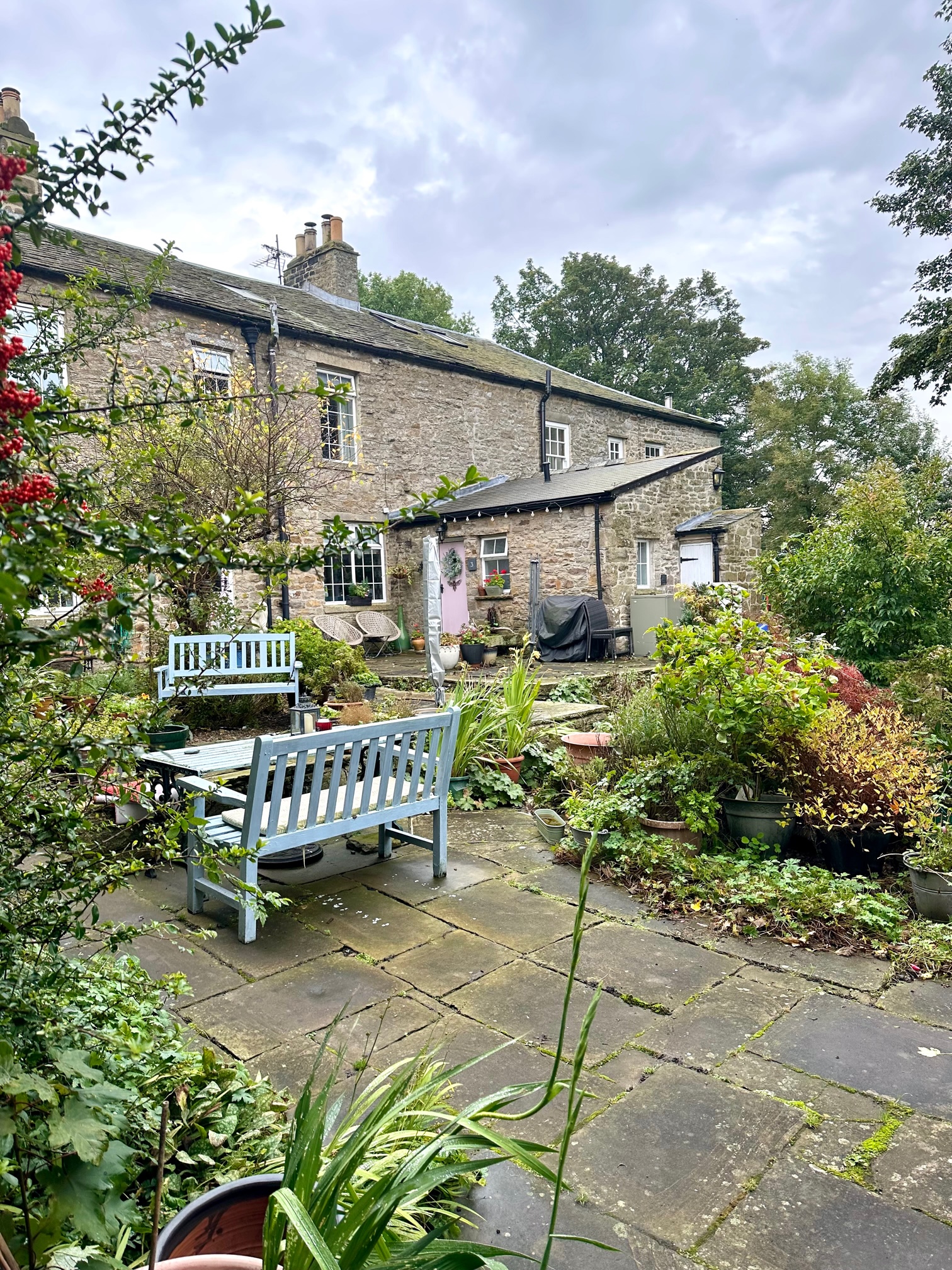
Photographs – The real “Dotheboys Hall” in Bowes – described by Dickens as “a long, cold-looking house”.
It’s hard to imagine what went on behind these walls as you peer over the wall today. Now converted into apartments, there’s a pretty courtyard with charming seating areas, pretty flower beds and colourful pot plants.
But close your eyes and the sights and sounds of Victorian England come rushing into your head, especially if you’ve read the story of “Nicholas Nickleby”.
Many years ago, I was lucky to see the Royal Shakespeare Company’s “The Life and Adventures of Nicholas Nickelby”, an epic piece of theatre, which burned the distressing conditions at Dotheboys Hall into my memory .

Photographs – Theatre programme for “The Life and Adventures of Nicholas Nickelby”
c/o Royal Shakespeare Company.
Some of its most memorable scenes featured a young pupil at the school called Smike, played by the actor John Lynch. I’ll never forget the abuse his character endured, his tormented look and terrified demeanour.
Seeing the actual Dotheboys Hall in Bowes sent a cold shudder down my spine, and took me right back to the book and the equally hard-hitting play.
Later on my trip to Bowes, I stumbled upon the real life Smike who inspired the character… in the village graveyard.
Cruel Schools


Photographs – Dotheboys Hall, Bowes in the 1840s. Images courtesy of the British Library Board
Bowes was home to nine private boarding schools in Victorian times, an astonishing number for a small village.
“Bowes Academy” was one of the largest schools at the west end of the village. At the far east side of the town, there was George Clarkson’s “Bowes Hall Academy”, an imposing stone building , now a handsome private mansion.
The Free Grammar School on the main street also accepted young boarders whilst across the fields to the south there was Mr Horn’s Gilmonby Hall Academy.
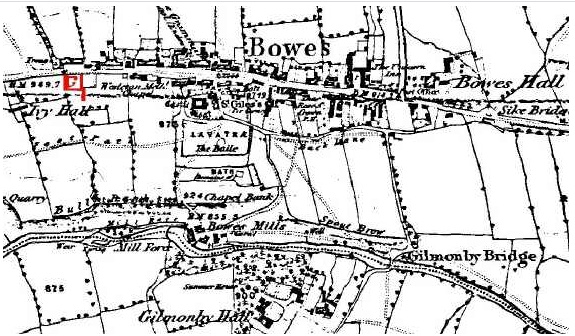
Map of Bowes village in 1857 with ‘Dotheboys Hall’ in red. Bowes Hall Academy was to the east side village.
The schools were remote so that families in the south of England could offload their unwanted offspring without fear of recrimination. Only a few students came from families hoping naively to improve their kids’ prospects.
Most pupils were illegitimate, others were orphaned or simply unwanted. The term “out of sight, out of mind” is the best way of describing the situation.
Adverts were placed for pupils in London and national newspapers, promising to turn pupils into “young gentlemen”.

ADVERT FOR BOWES HALL SCHOOL
“At Bowes Hall Academy near Greta Bridge, Yorkshire, Mr Clarkson boards, in conjunction with able assistants, instructs young gentlemen in the English, Latin, and Greek languages, writing, arithmetic, merchants’ accounts, mensuration, and the most useful branches of mathematics, at 20 guineas per annum, if under 10 years of age; above 10, and under 14, 22 guineas… the French language at 2 guineas a year extra”.
On the face of it, Bowes Hall School looked to provide decent quality education with classical subjects offering an academic grounding whilst commercial subjects promised to improve a child’s future job prospects.
The lack of school vacations was perfect for parents who wanted to have very little oversight of their children, although they could visit the school, if they wanted. Few took the opportunity to make the long haul trip.
Life at Dotheboys Hall


But the reality of life at the boarding schools was far from that promised by the owners in their adverts.
Dotheboys was later revealed to be one of the Victorian era’s horror stories, a symbol of oppression and child cruelty.
Anyone who has has read Dickens’ classic novel, “Nicholas Nickleby”, will never forget its cruel headmaster, Wackford Squeers and his unpleasant wife.
Together the pair subjected the pupils to a life of misery with beatings, hard labour, bullying and floggings. Who could forget Mrs Squeers yelling at the boys and dispensing “brimstone and treacle”?
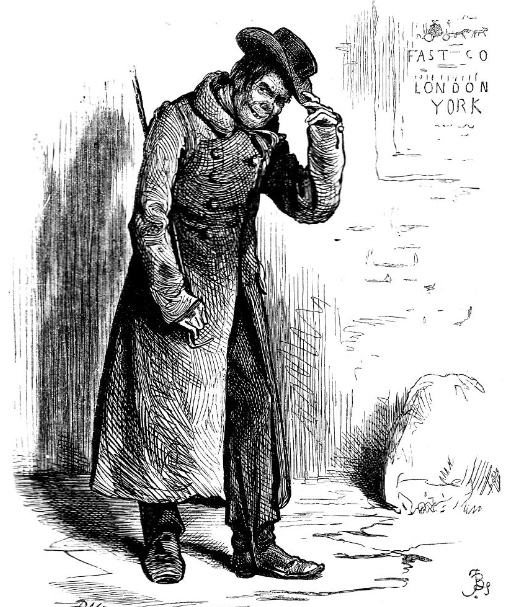
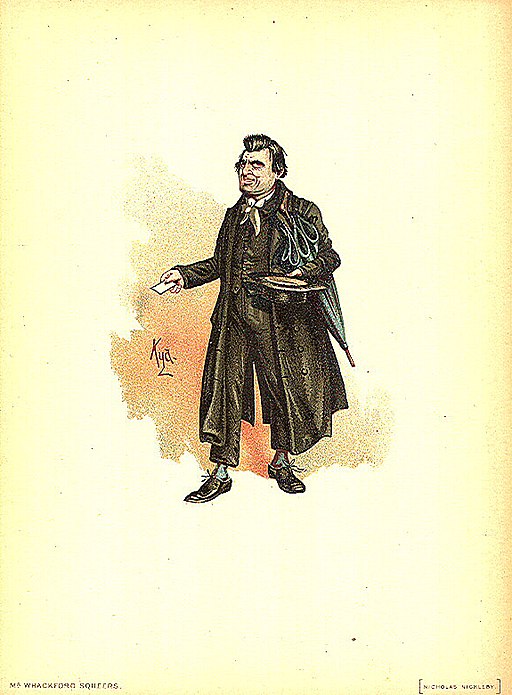
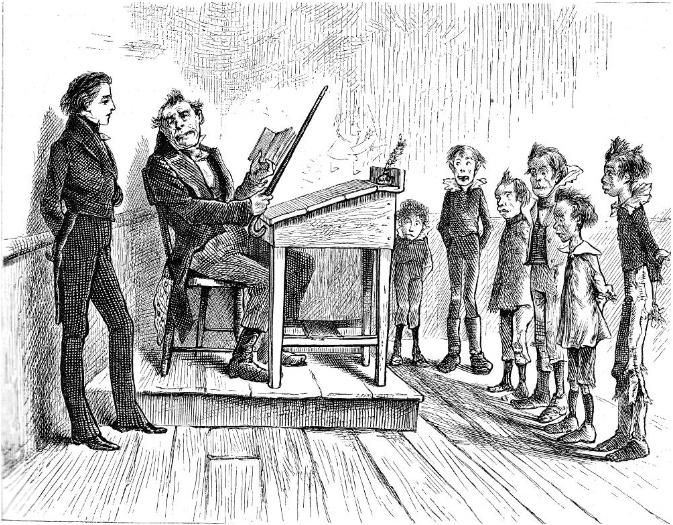
Photographs – Wackford Squeers depicted by Phiz and in various Victorian cartoons.
The character of Wackford Squeers is said to have been based on William Shaw who became an assistant schoolmaster at Bowes Hall Academy, run by George Clarkson, in the early 1800s.
The school had around 250-300 boarder pupils at any one time.
Adverts for the school gave its location as nearby Greta Bridge, a small village nearby. It was the closest staging post on the coach journey from London via Scotch Corner to Glasgow.
At the end of 1810 Shaw married into an affluent Bowes family and acquired a large portfolio of property in Bowes. By 1814 he had become the proprietor of his own school and also started advertising regularly in The Times.

“Dotheboys Hall Breaks Up Forever” by Edgar Bundy c/o Charles Dickens Museum, London
The Bowes Academy advert quoted an annual fee of 20 guineas per annum, amongst the cheapest anywhere in the country. It included the pupil’s clothing as part of the package. It’s clear today that William Shaw was trying to undercut his former employer to recruit students.
In October 1823, two civil cases were brought to the court at the Guildhall in London in which William Shaw was sued by the parents of two boys at his academy for gross negligence. They argued that the school’s cruel regime had left one of the youngsters blind.
Both pupils gave evidence about life at Bowes and their damning accounts were reported in The Times:
“The boys washed in a long trough, like what horses drink out of: the biggest boys used to take advantage of the little boys, and get the dry part of the towel. There were two towels a day for the whole school. We had no supper; nothing after tea. We had dry bread, brown, and a drop of water and a drop of milk warmed. The flock of the bed was straw; one sheet and one quilt; four or five boys slept in a bed not very large. My brother and three more slept in my bed; about 30 beds in the room.”
Evidence from pupil at the 1823 Court Case
Another witness, a French teacher, commented that “he would not expose a dog”’ to the treatment the boys had to endure at Bowes Academy.
At the end of the court case, William Shaw was forced to pay £300 in damages to the pupils’ families, an enormous amount of money, running into millions in today’s figures.
But little changed – life returned to normal for William Shaw and the Bowes Academy. The court case did little to deter parents from sending their children there.
The judge declared that “there was nothing to impeach the general conduct of Mr Shaw in the management of the school”. This seems remarkably lenient after hearing the boys’ descriptions of life at the Academy.
Dickens in County Durham
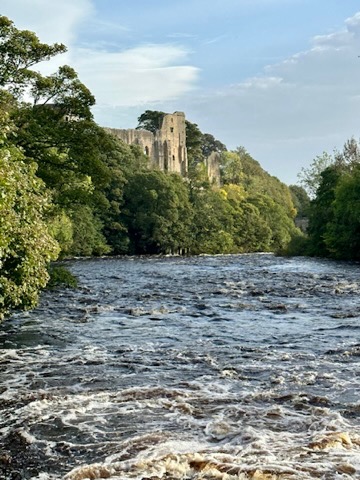

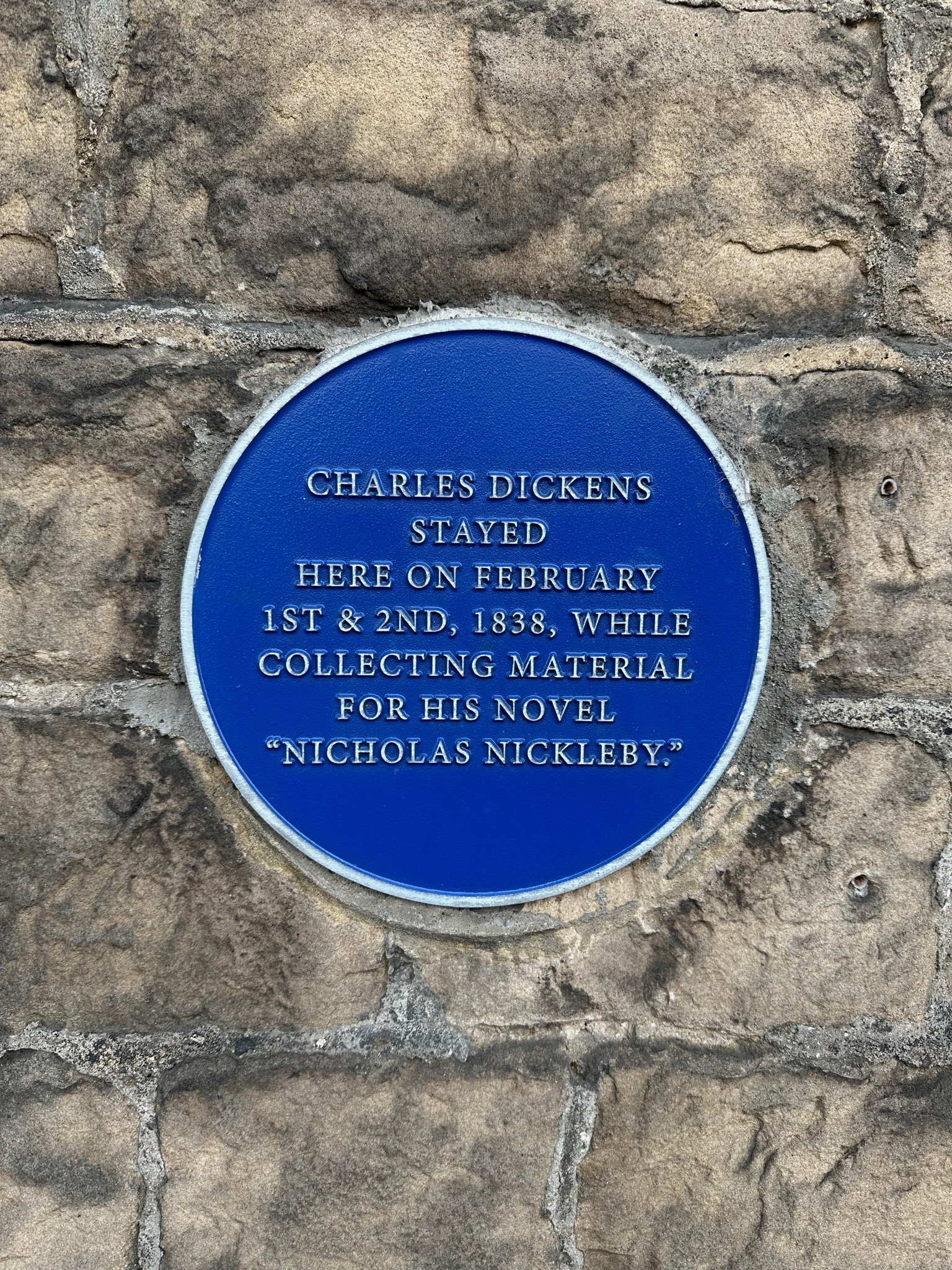
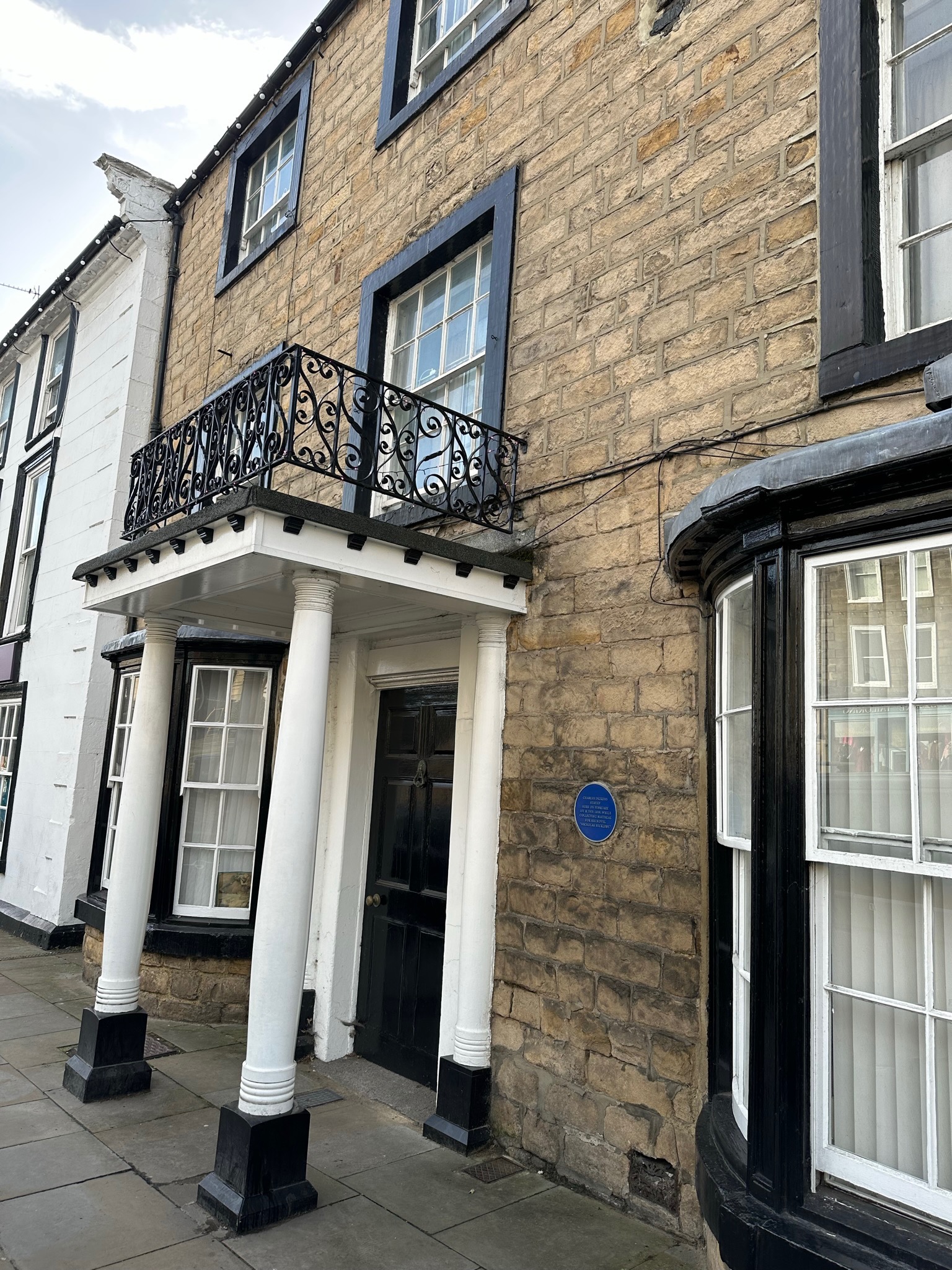
Photographs – Barnard Castle and the former King’s Head where Charles Dickens stayed on his trip
But Bowes Academy and the private boarding schools in Yorkshire and County Durham weren’t to escape scrutiny for very much longer.
Fifteen years later in 1838, author Charles Dickens and his illustrator Hablot Browne (Phiz) travelled north on a tour of boarding schools, staying at the King’s Head in Barnard Castle.
It took them 27 hours to make the long road trip north to research a new novel called “Nicholas Nickelby”.
They’d heard worrying stories about the private schools, and wanted to investigate for themselves. They met with a solicitor and listened to local tales about the schools before continuing their journey.
The following morning, they took the stagecoach into nearby Bowes village, where they stopped at the 16th Century coaching inn, The Ancient Unicorn.
The weather was wintery and snow lay on the ground. Dickens remarked on the bleak nature of the surrounding countryside and moors.


They headed up the main street and attempted to visit the boarding schools, but word had spread that two outsiders were sniffing around.
Dickens attempted to gain entry to the Bowes Academy but was refused admission. But he did encounter William Shaw, its headmaster, on the doorstep, and was struck by Shaw’s one eye and odd-looking appearance.
In “Nicholas Nickelby”, Charles Dickens describes Wackford Squeers as having a single eye, a face “much wrinkled and puckered up, which gave him a very sinister appearance, especially when he smiled”, “.
Dickens notes that at times “his expression bordered closely on the villainous”.
After his visit, Dickens discovered the numerous graves of schoolchildren in the church graveyard including that of George Ashton Taylor, who had died at Shaw’s Academy in 1822, aged 19.
The young man was to inspire the abused character of young Smike, in “Nicholas Nickelby”.



Dickens was later to write a scathing critique of the northern schools like Bowes in the preface to his novel:
“These Yorkshire schoolmasters were the lowest and most rotten in the whole ladder. Traders in the avarice, indifference, or imbecility of parents, and the helplessness of children…
“Ignorant, sordid, brutal men, to whom few considerate persons would have entrusted the board and lodging of a horse or a dog; they formed the worthy corner-stone of a structure, which, for absurdity and a magnificent high-handed laissez aller neglect, has rarely been exceeded in the world.”
The public furore caused by Dickens was to be the nail in the coffin of the brutal regime at schools like the Bowes Academy.
From Cradle to Grave



Photograph – The graves of school master William Shaw and pupil George Ashton Taylor.
The final advert for the Bowes Academy appeared in The Times newspaper in 1840, but the days of the “boy farming” schools were numbered.
By 1841 William Shaw was no longer working as a schoolmaster at Bowes. Records reveal that he was living as a gentleman of independent means. He died in Bowes in 1850 at the age of 67 and was buried in St Giles’ churchyard.
It’s easy to find his grave in St Giles Church. I was struck by the large and imposing headstone close to the church’s main entrance.
The family grave is shared with his own son who died in 1837, aged only 24 years old. A chilling reminder that ‘wealth can’t buy you health’ – and perhaps a punishment of sorts for William Shaw?

Not far away from his grave at the back of the churchyard is another tombstone – that of George Ashton Taylor, thought to be the inspiration for the character of Smike, the school friend of Nicholas Nickelby.
The words on his headstone read: “Died suddenly at William Shaw’s Academy of this place, April 13, 1823, aged 19 years”. George was originally from Wiltshire, and I felt sad to learn that he’d died so far from his home town.
On his visit, Charles Dickens took inspiration from George’s tragic story in “this wretched place”. He wrote: “I think his ghost put Smike into my mind upon the spot”.


Photographs – Smike at Dothebys Hall and recruiting pupils c/o Phiz and Look and Learn magazine.
Charles Dickens describes him as “a timid, broken-spirited creature” when we meet him for the first time in the book.
There are many similar graves of young boys listed in the Burial Register for St Giles’ Church – and it’s poignant to walk amongst these headstones. How many other ‘Smikes’ were there? Perhaps we will never know for sure.
Extract from the Graveyard list at Bowes Church c/o The Dickens Fellowship

Old School Days
Today we look back on “the Yorkshire Schools” and their harsh regimes with a mixture of disgust, shock and horror.
It’s hard to believe that the teachers needed no qualifications, and that floggings and beatings were commonplace.
Despite attempts by his family to reclaim his reputation, William Shaw remains a likely inspiration for the character of Mr Squeers in “Nicholas Nickelby”.
It’s worth remembering that Dotheboys was not the only school of this type. There were similar establishments in Ripon, Brough and Startforth, but Bowes was the centre of the private school system.
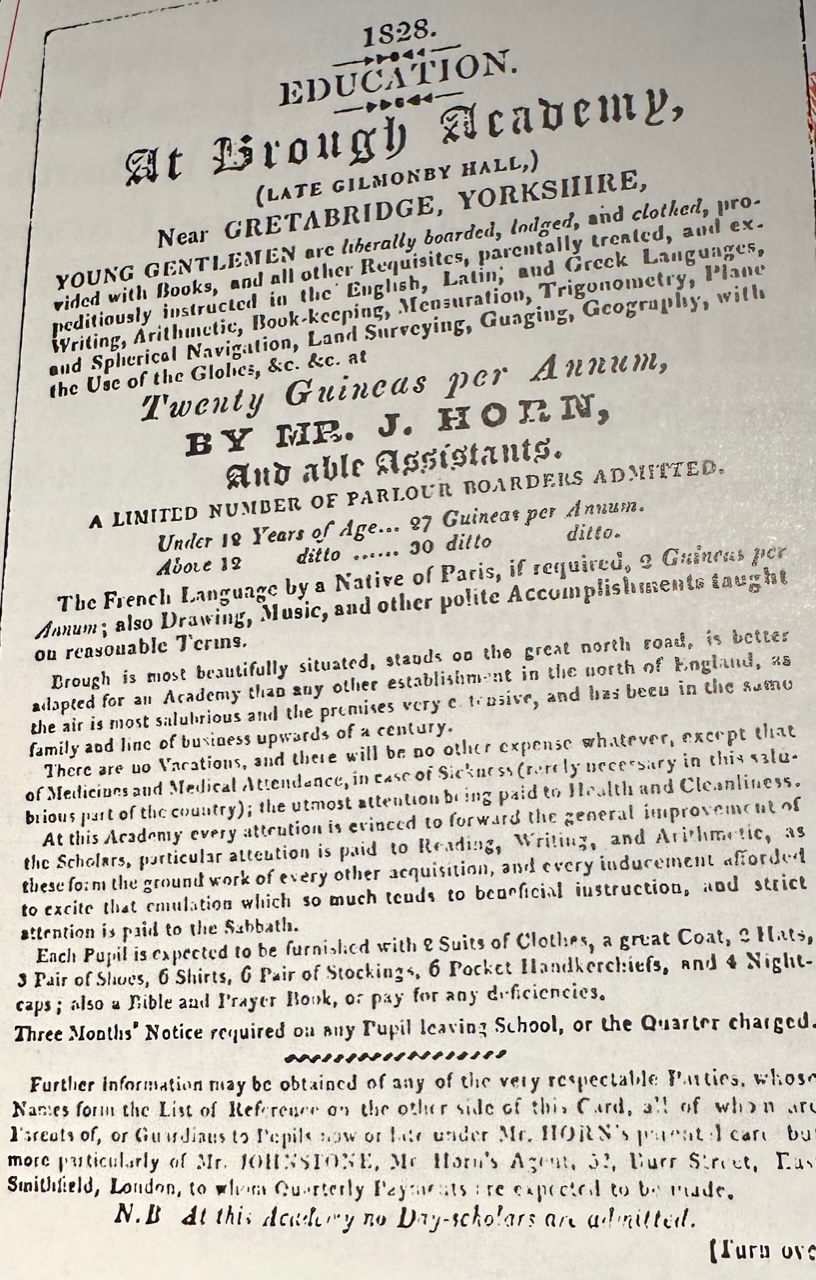

Photographs – Adverts for the Bowes boarding schools were common in Victorian newspapers.
William Shaw was not the only master of questionable character. George Clarkson who ran the school in Bowes Hall hired out his pupils as labourers on local farms rather than raising them as young gentlemen, as he’d promised.
There was also the curious incident of his wife’s “murder” when she was found at the bottom of the hall stairs which remains a mystery. One of his staff was acquitted of her murder but exactly what happened is a Victorian whodunnit.
Reverend Joseph Adamthwaite was master of the Free Grammar School of Bowes at a salary of £300 per annum, a huge amount of money in Victorian times. Adamthwaite later ran his own school academy at nearby Cotherston.
The annual school fees were 16 guineas a year including “education, board, lodging, washing and every other necessity”. Each boy was expected to bring with him “two suits of clothes, six good shirts, six pairs of stockings, two night caps, two pairs of shoes and two hats”.
But like all the boarding schools and their masters, it’s hard to know if his intentions were entirely honourable.
One thing that we do know is the cruel and oppressive regimes run by many of these schools were shocking.
Bowes was at the heart of this abuse and was far from the “delightful village” described in the Victorian adverts designed to attract young pupils.
Instead, it became a hell hole and a graveyard for many of the young pupils who were brought here.
Today it’s hard to imagine the cruel schools which sprung up in this outwardly calm and remote village. But it’s worth discovering the true tale of this Victorian horror story…
Top Attractions – Bowes
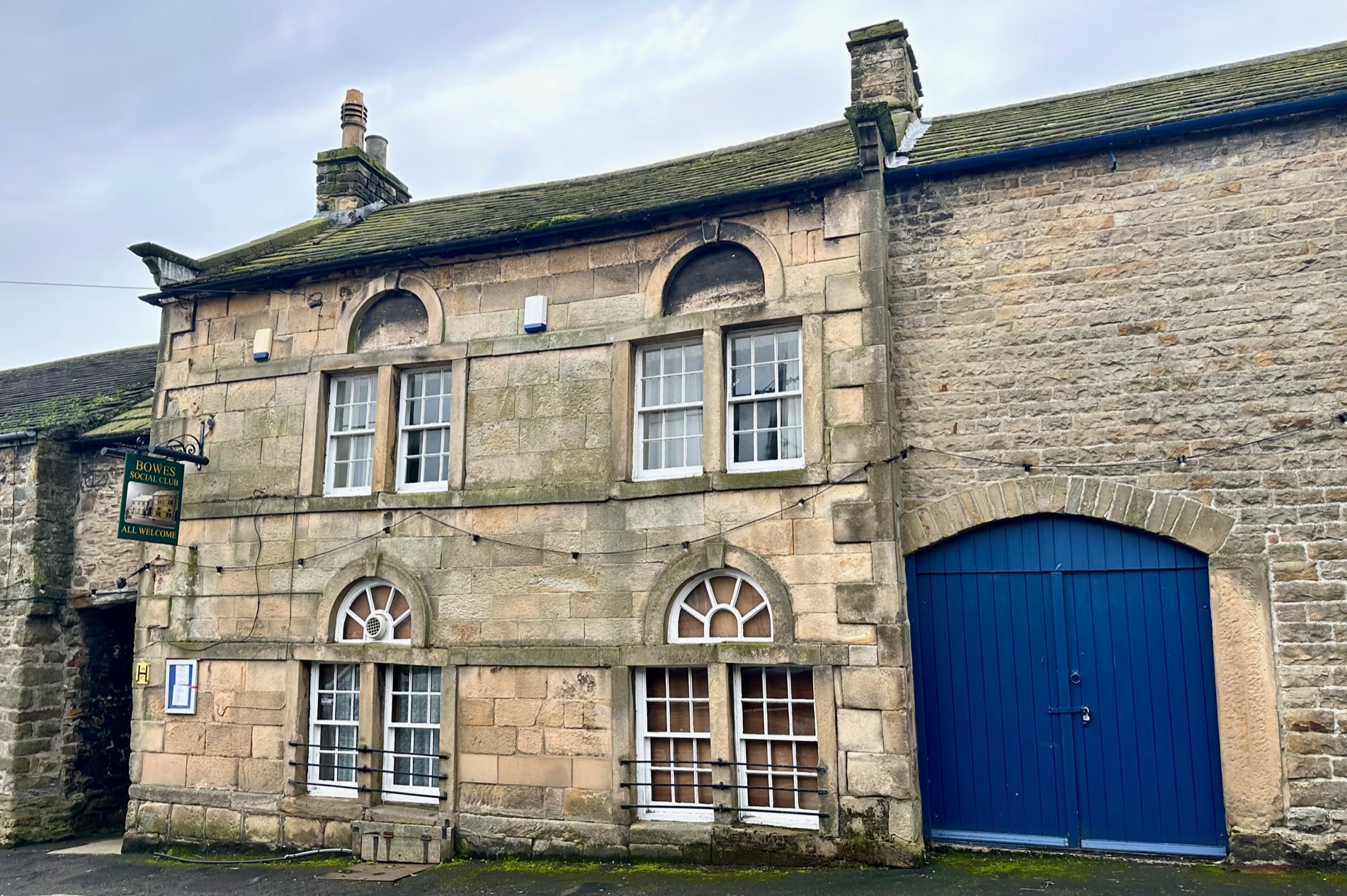
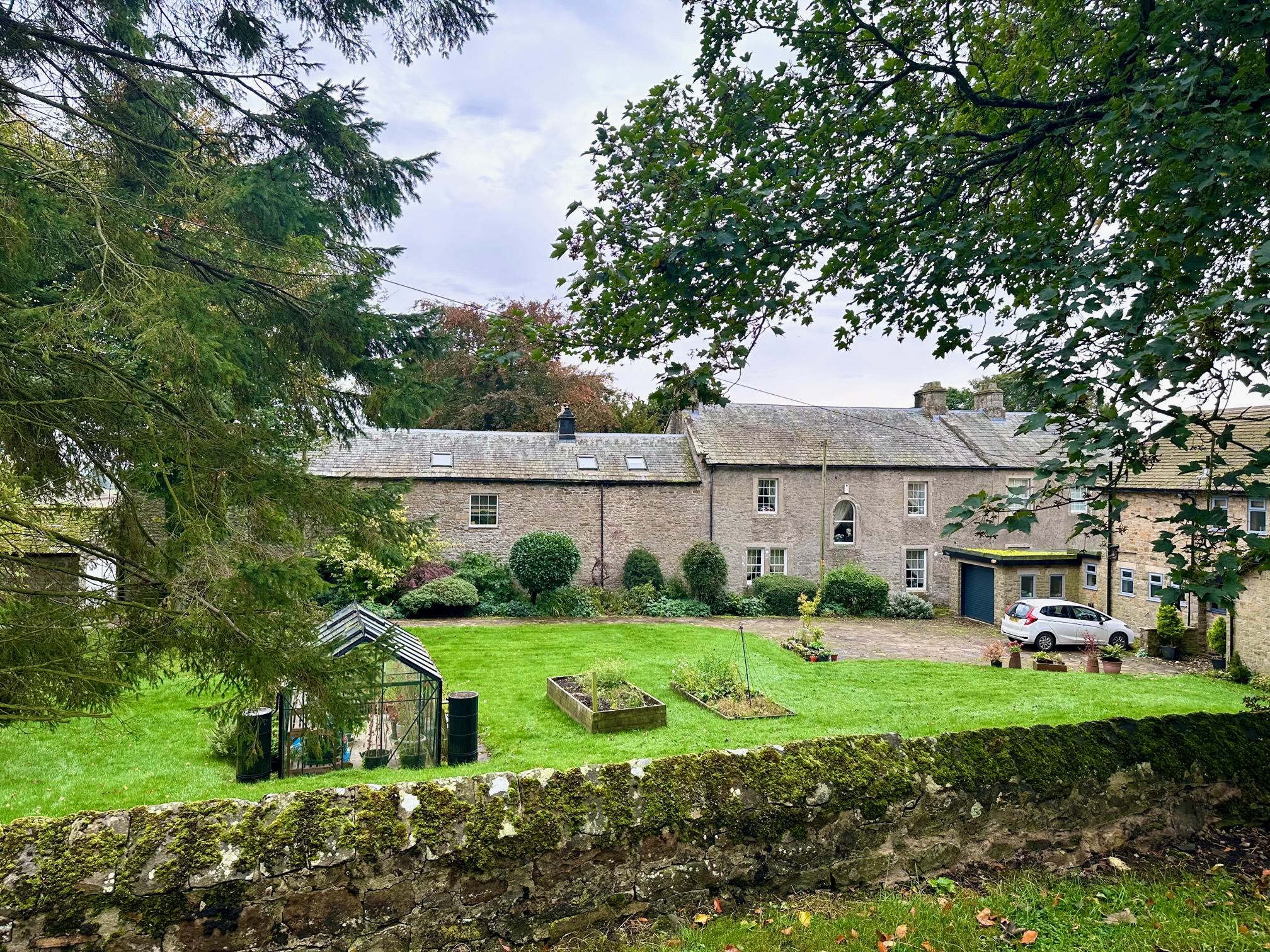

Bowes’ starring role in Charles Dickens’ tale of “Nicholas Nickelby” is a remarkable story. There’s still plenty of evidence of the village’s Victorian past today.
The building that once housed the Bowes Academy has been converted into private flats and is not open to the public. But you can peep into the gardens and courtyard from the main street, and look over the hedge into the grounds.
The imposing Bowes Hall is no longer a public building – but it can be seen from the road at the end of the village. It’s now a private home which recently sold for over £1 million.
Sadly, the former Gilmonby Hall to the south of Bowes was demolished in 1945 after being requisitioned by the military in World War Two.

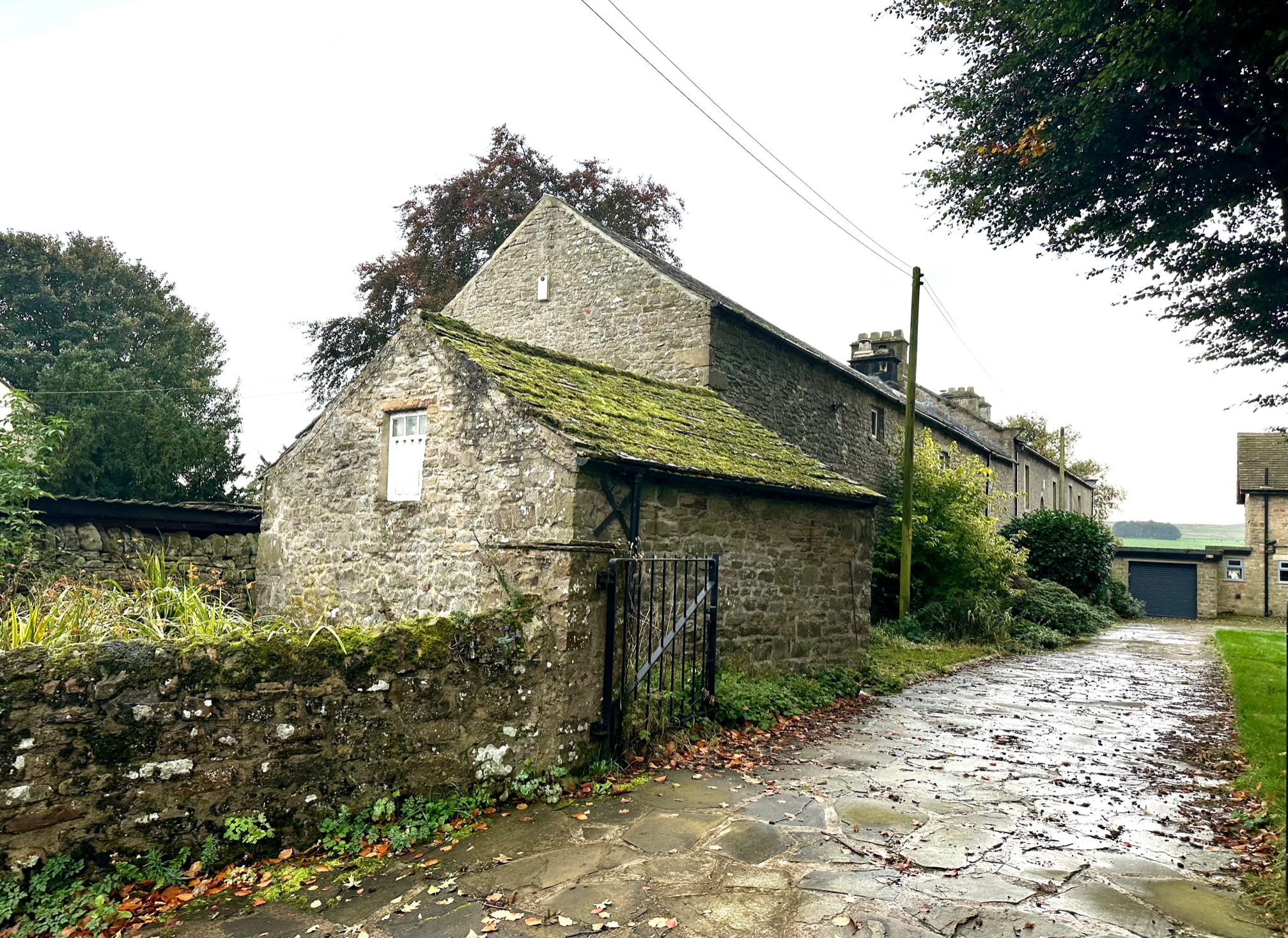

Photographs – Bowes Castle ruins, typical stone farm building and Bowes Hall c/o Jackson Stops Estate Agents.
Don’t miss the Church of St Giles, a fascinating Norman building dating from the 12th Century with a wealth of historic treasures including Roman artefacts. The church contains the gravestones of many of the real life characters who inspired Charles Dickens as well as some of the teachers.
The Ancient Unicorn is a historic public house, restaurant and hotel on The Street which dates back 400 years. Recently refurbished, this old coaching inn offers overnight accommodation, a restaurant and bars. It’s supposed to be haunted – and there’s definitely a strange, disturbing vibe when wandering around the building.
The old steps can be seen where Charles Dickens and his companion Phiz climbed down from their horse drawn carriage in 1838. They also dined at the pub before visiting the private boarding schools.
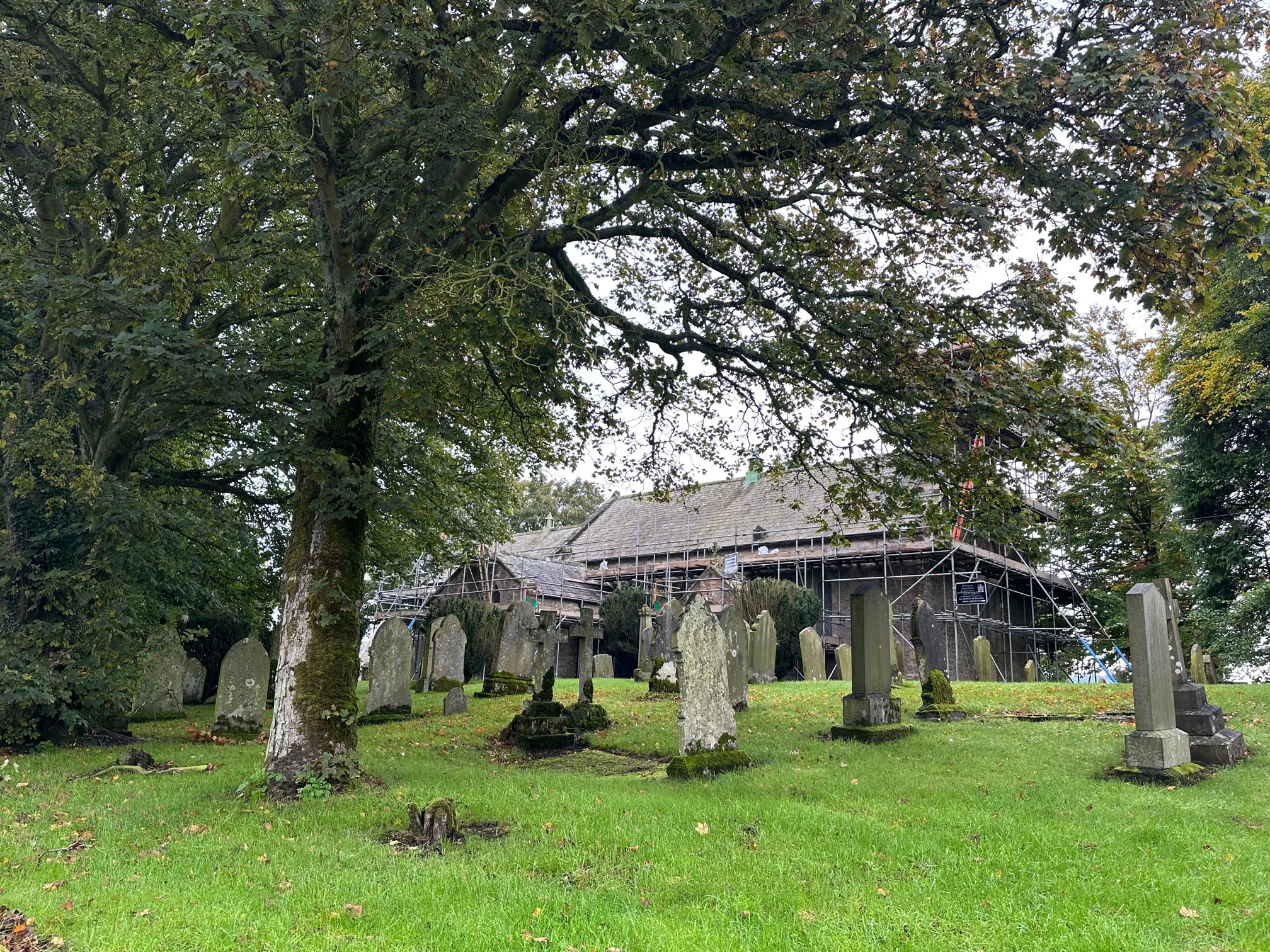

Photographs – St Giles Church and churchyard.
Bowes Castle lies in ruins to the south of the village close to scattered remains of an ancient Roman settlement. Charles Dickens would have seen the castle as he wandered the village looking at the private boarding schools. The castle stands in a field surrounded by a moat on two sides.
Why not take the four mile trip into nearby Barnard Castle? This historic market town boasts a large, ruined castle in a stunning setting overlooking the river Tees.
There are many traditional old shops in the town including several buildings associated with Charles Dickens. It is here that an old clock shop inspired another Dickens story and his novel, “The Old Curiosity Shop”.
Not far away is the Bowes Museum, an impressive building in the style of a French Chateau with period rooms, amazing artefacts and a historic collection.


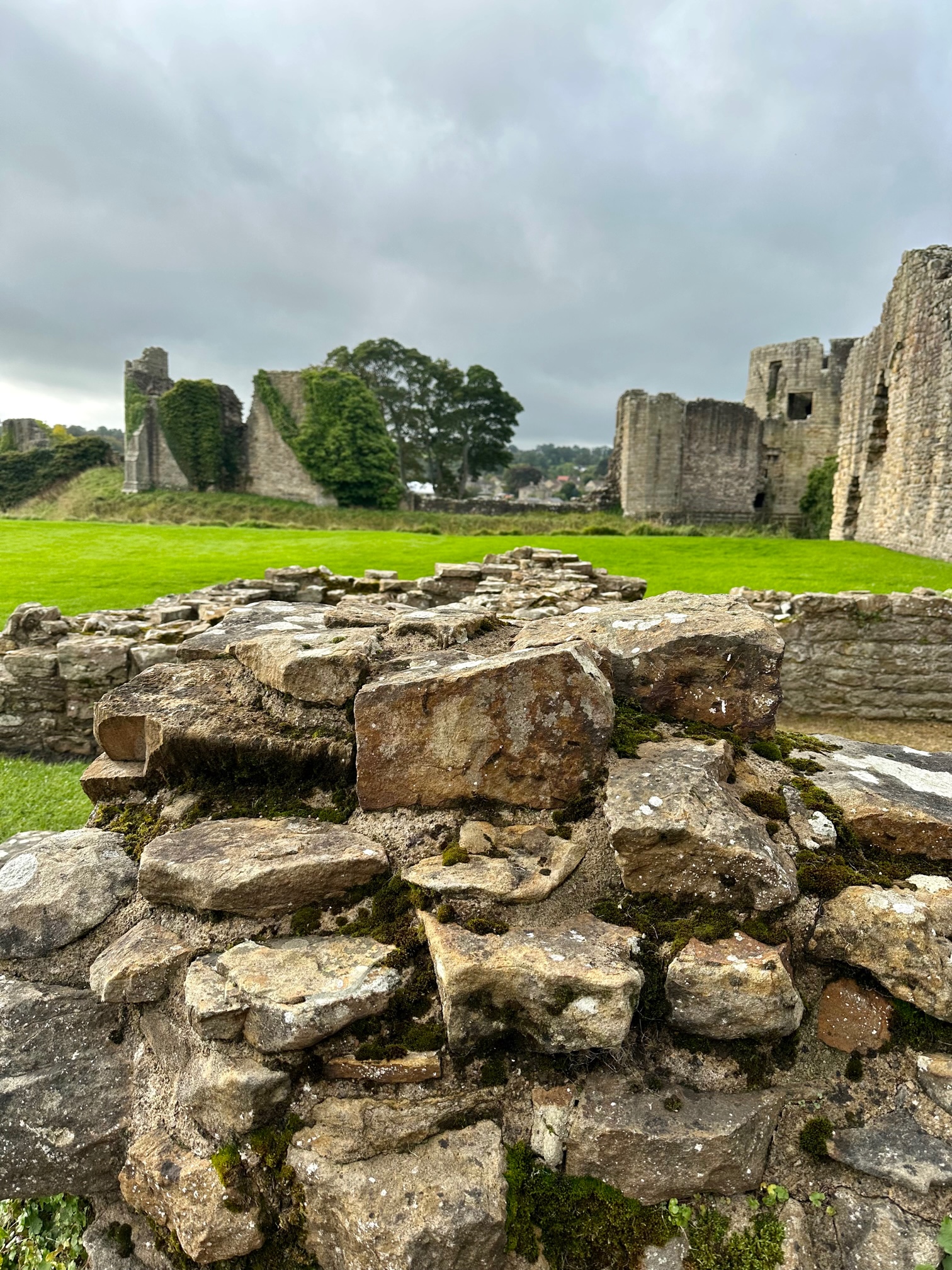
Photographs – Barnard Castle , the Teesdale countryside and Bowes ‘old Roman town remnants.
Categories: England, Heritage, History, literature, north east england, Travel, Travel, UK


